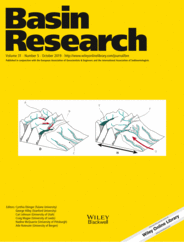
Full text loading...

Extensional faults and folds exert a fundamental control on the location, thickness and partitioning of sedimentary deposits on rift basins. The connection between the mode of extensional fault reactivation, resulting fault shape and extensional fold growth is well‐established. The impact of folding on accommodation evolution and growth package architecture, however, has received little attention; particularly the role‐played by fault‐perpendicular (transverse) folding. We study a multiphase rift basin with km‐scale fault displacements using a large high‐quality 3D seismic data set from the Fingerdjupet Subbasin in the southwestern Barents Sea. We link growth package architecture to timing and mode of fault reactivation. Dip linkage of deep and shallow fault segments resulted in ramp‐flat‐ramp fault geometry, above which fault‐parallel fault‐bend folds developed. The folds limited the accommodation near their causal faults, leading to deposition within a fault‐bend synclinal growth basin further into the hangingwall. Continued fold growth led to truncation of strata near the crest of the fault‐bend anticline before shortcut faulting bypassed the ramp‐flat‐ramp structure and ended folding. Accommodation along the fault‐parallel axis is controlled by the transverse folds, the location and size of which depends on the degree of linkage in the fault network and the accumulated displacement on causal faults. We construct transverse fold trajectories by tracing transverse fold hinges through space and time to highlight the positions of maximum and minimum accommodation and potential sediment entry points to hangingwall growth basins. The length and shape of the constructed trajectories relate to the displacement on their parent faults, duration of fault activity, timing of transverse basin infill, fault linkage and strain localization. We emphasize that the considerable wavelength, amplitudes and potential periclinal geometry of extensional folds make them viable targets for CO2 storage or hydrocarbon exploration in rift basins.

Article metrics loading...

Full text loading...
References


Data & Media loading...

